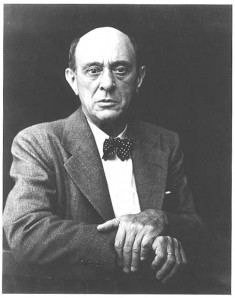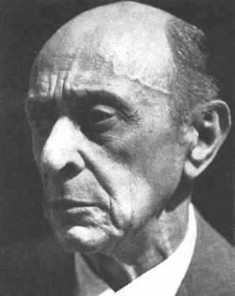| Arnold Schoenberg | |
|---|---|
 |
|
| Composer | |
| Born | Sep. 13, 1874 |
| Died | July 13, 1951 |
| Nationality | Austrian |
Arnold Schoenberg was an Austrian composer who later lived in the United States. He was also a music theorist and an accomplished painter, and he is considered the leader of the Second Viennese School. Schoenberg’s approach to music developed from bringing together the styles of Wagner and Brahms to far more experimental compositions.
Early Years
Schoenberg was born in Vienna on September 13, 1874. The date was significant because he had a fear of the number 13 throughout his life. He started to study the violin when he was at age eight, quickly moving on to composing simple works. However, these were trivial as he lacked any formal training until the early 1890s.
At that point, he began to be taught by Zemlinsky, and the two formed a close friendship. Schoenberg was into his mid-twenties before he produced any significant compositions; these include a selection of songs and a string sextet. They displayed strong influence from both Wagner and Brahms, despite the two composers’ works generally being considered of entirely different character.
Beginning a Musical Career
From 1901, Schoenberg spent two years in Berlin, teaching and performing in cabaret. He produced Pelleas und Melisande, a symphonic poem which took the model established by Strauss and brought to it extra richness of counterpoint and a greater density of themes.
On his return to Vienna in 1903, Schoenberg moved into private tutoring, teaching some – such as Berg – who would go on to become significant figures in their own right. Schoenberg’s own style quickly evolved, with the grand orchestra of his early works being reduced to a much smaller ensemble of little more than a dozen, as seen in his Chamber Symphony No. 1.
Schoenberg’s Atonal Arrangements
By now, Schoenberg’s music contained dense, complex arrangements that incorporated strange, clashing harmonies. His first string quartet was written as a single movement rather than the four that had been usual up to that point.
In 1908, he moved on to develop atonality in his work, even as he tried to include more and more disruptive elements in his music. His Chamber Symphony, for example, had included a run of fourths. Schoenberg did not entirely abandon tonality, as can be seen from  his Suite in G of the 1930s, as well as his second Chamber Symphony and certain examples of band music.
his Suite in G of the 1930s, as well as his second Chamber Symphony and certain examples of band music.
Nevertheless, from 1908 onward, the composer abandoned the idea of a sense of key, for example in his use of poems in the final movements of his String Quartet No. 2. For several years, he continued to work in this pioneering style, with rhythmic structure and traditional themes also being dropped. His shorter works, such as Five Orchestral Pieces, can be described as Expressionist, with one intense state of music being defined by a number of short examples.
In Erwartung, Schoenberg describes the dramatic story of an angry woman looking for a lover. Other pieces, such as Die Jakobsleiter, dealt with the relationship of God and the soul. Many of his compositions from this time explore the jarring idea of the personality simply falling apart.
Important Works
In the 1920s, after discovering that he could use his twelve-note method for composing longer pieces, Schoenberg once again embraced more conventional musical forms. Major works from this period include his String Quartet No. 3, a number of choral and orchestral variations, and his Suite for Piano. It was at this time, too, that he set up the Society for Private Musical Performances.
Schoenberg lost his wife in 1923, but he married again the following year. In 1925, he set up a home in Berlin. Here, while working at a master class at the Prussian Academy of Arts, he worked on Moses und Aron, an opera which was never completed. The opera dealt with whether truth could be communicated without distortion.
Later Years and Death
With the coming to power of Hitler in 1933, Schoenberg as a Jew was forced to leave Germany. He traveled to Paris and decided to leave the Lutheran church, where he had been for over 30 years, to return to Judaism. He failed in his attempts to immigrate to Britain, instead settling in Los Angeles in 1934.
In Los Angeles, he began to work with tonal music once more, although his teaching job at UCLA meant that he produced little for some years after 1936. Schoenberg suffered a heart attack in 1945, after which he ceased to teach and wrote an expressionist string trio, A Survivor from Warsaw.
He died on Friday, July 13, 1951, just before midnight, having spent the entire day in bed owing to his terror of the date.